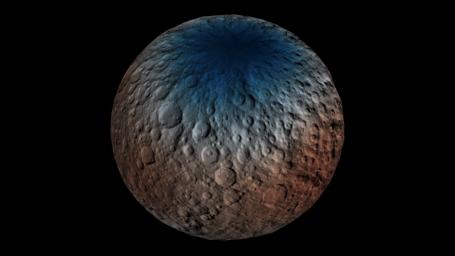Ceres Neutron Counts Reflect Hydrogen Abundance
Caption:
This map shows a portion of the northern hemisphere of Ceres with neutron counting data acquired by the gamma ray and neutron detector (GRaND) instrument aboard NASA's Dawn spacecraft.
These data reflect the concentration of hydrogen in the upper yard (or meter) of regolith, the loose surface material on Ceres. The color information is based on the number of neutrons detected per second by GRaND. Counts decrease with increasing hydrogen concentration. The color scale of the map is from blue (lowest neutron count) to red (highest neutron count).
Lower neutron counts near the pole suggest the presence of water ice within about a yard (meter) of the surface at high latitudes.
The GRaND data were acquired from Dawn's low-altitude mapping orbit (LAMO) at Ceres, a distance of 240 miles (385 kilometers) from the dwarf planet. The longitude is centered on Occator Crater.
Background Info:
Dawn's mission is managed by JPL for NASA's Science Mission Directorate in Washington. Dawn is a project of the directorate's Discovery Program, managed by NASA's Marshall Space Flight Center in Huntsville, Alabama. UCLA is responsible for overall Dawn mission science. Orbital ATK, Inc., in Dulles, Virginia, designed and built the spacecraft. The German Aerospace Center, the Max Planck Institute for Solar System Research, the Italian Space Agency and the Italian National Astrophysical Institute are international partners on the mission team. For a complete list of acknowledgments, see
http://dawn.jpl.nasa.gov/mission
.
For more information about the Dawn mission, visit
http://dawn.jpl.nasa.gov
.
Cataloging Keywords:
| Name |
Value |
Additional Values |
| Target |
1 Ceres |
|
| System |
Main Belt |
|
| Target Type |
Dwarf Planet |
Asteroid |
| Mission |
Dawn |
|
| Instrument Host |
Dawn |
|
| Host Type |
Orbiter |
|
| Instrument |
Gamma Ray Spectrometer (GRS) |
|
| Detector |
|
|
| Extra Keywords |
Color, Crater, Map, Water |
| Acquisition Date |
|
| Release Date |
2016-03-22 |
| Date in Caption |
|
|
| Image Credit |
NASA/JPL-Caltech/UCLA/MPS/DLR/IDA/PSI |
| Source |
photojournal.jpl.nasa.gov/catalog/PIA20353 |
| Identifier |
PIA20353 |

 Planetary Data System
Planetary Data System
